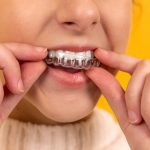
Maintenance of good oral health is important for the prevention of caries and periodontal disease. Studies have shown that orthodontic fixed appliances can increase plaque accumulation leading to enamel demineralisation and gingival inflammation without effective oral hygiene. With the increasing use of clear aligners that can be removed to facilitate oral hygiene studies have suggested that they can better maintain periodontal health.
The aim of this review was to assess periodontal health maintenance and gingival recessions development in patients undergoing an orthodontic treatment with clear aligners (CA) and fixed appliances (FA).
Methods
A protocol for the review was registered in the PROSPERO database. Searches were conducted in the Cochran Library, Medline/PubMed, Scopus, and the Web of Science, Clinical trials.gov, OpenGrey and www.greylit.org databases. Randomised clinical trials (RCTs), controlled clinical trials (CCTs) and prospective or retrospective cohort studies assessing the periodontal health status and gingival recession development in patient undergoing orthodontic treatment with buccal FA and CA were considered. The primary outcome was periodontal health status measured using plaque index (PI), pocket probing depth (PPD), gingival index (GI) and bleeding on probing (BoP). Development or increase of gingival recession was a secondary outcome. Outcomes were grouped as short-term (baseline to 2-3 months), mid-term (baseline to 6-9 months) and long-term (baseline to 12 months or more). Two reviewers independently selected studies and extracted data with risk of bias being assessed using the risk of bias in non- randomized studies of interventions (ROBINS-I) for non-randomised studies and the risk of bias tool (RoB 2.0) for RCTs. Meta-analyses were performed when studies reported the same periodontal indices at the same follow-up.
Results
- 12 studies (3 RCTs, 8 prospective cohorts,1 retrospective cohort) involving a total of 612 patients (291 CA, 321 FA) were included.
- One of the RCTs was considered to be at low risk of bias 2 at high risk. All the cohort studies were assessed as at moderate risk of bias.
- For Plaque index (PI) 6 studies contributed to a meta-analysis with statistically significant benefits in favour of CA for mid-term follow-up but not for short or long-term follow-up (see table below).
- 4 studies not included in the meta-analysis demonstrated better PI results for CA at 6 and 12 months follow-up.
- Only 4 studies contributed to a meta-analysis of gingival index (GI) with no statistically significant differences being found (see table below).
- For pocket probing depth (PPD) 5 studies were included in the meta-analyses. No statistically significant differences were seen at short, and mid-term follow up, although a single long-term study did demonstrate statistically significant results favouring CA.
- 8 studies assessed bleeding on probing (BoP) but due to variation in measuring indices no meta-analyses were conducted. 7 of the eight studies suggested a benefit for CA.
- Only one study reported on gingival recession suggesting reduced recession with CA.
| Outcome | No. of studies (patients) | Mean Difference (95%CI) |
| PI – short term | 4 (187) | -0.62 (-1.41 to 0.18) |
| PI – mid term | 4 (203) | -0.99 (-1.94 to -0.03) |
| PI – long term | 2 (108) | -1.12 (-3.13 to 0.08) |
| GI – short term | 1 (60) | 0.04 (-0.14 to 0.22) |
| GI – mid term | 2 (96) | -0.46 (-1.41 to 0.49) |
| GI – long term | 2 (161) | -0.46 ( -1.03 to 0.33) |
| PPD – short term | 4 (214) | -0.06mm (-0.45 to 0.33) |
| PPD – mid term | 2 (82) | -0.29mm (-1.41 to -0.07) |
| PPD– long term | 1 (47) | -0.93mm (-1.16 to 0.7) |
Conclusions
The authors concluded: –
Up to the date there is not enough evidence to conclude that CA maintains better periodontal health during an orthodontic treatment than FA.
Comments
The reviewers preregistered their protocol and searched a wide range of databases identifying 12 studies in all. Of the included studies only 3 were RCTs and two of these were considered to be at high risk of bias. In a previous blog (Dental Elf – 13th Jan 2015) we looked at a 2014 review of this topic which included 5 studies only one of which was an RCT. Considered the grow in use of CA over the past 10 years in is perhaps disappointing that few high quality RCTs on this topic have been conducted. The authors have assessed several periodontal outcomes conducting a number of meta-analyses, but few studies contribute data to them. Consequently, while some statistically significant differences were identified these should be interpreted very cautiously. In addition, and as the authors point out while statistically significant their clinical significance is negligible.
Links
Primary Paper
Crego-Ruiz M, Jorba-García A. Assessment of the periodontal health status and gingival recession during orthodontic treatment with clear aligners and fixed appliances: A systematic review and meta-analysis. Med Oral Patol Oral Cir Bucal. 2023 Jan 15:25760. doi: 10.4317/medoral.25760. Epub ahead of print. PMID: 36641738.
Other references
Dental Elf – 13th Jan 2015
Periodontal health: improved during clear aligner treatment suggests review
Picture Credits
Photo by Diana Polekhina on Unsplash
